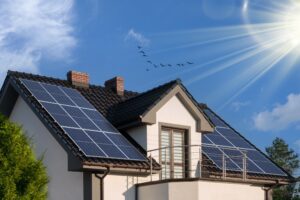How Much Power Does A Solar Panel Produce?
Solar panels can save households hundreds of pounds a year on fuel bills, plus any surplus electricity can be sold to the National Grid to generate an income. To maximise your savings, you’ll need a solar panel set up of sufficient power output to meet your demand.
Maximising the benefits of going solar requires a basic grasp of solar panel power output in terms of wattage. This will enable you to choose the size of solar energy system needed to meet the electricity requirements of your home.
Central to this decision is knowing how much power solar panels can generate and the difference between power and energy, plus how each is measured.
But the world of solar, energy, and power is full of technical terms and abbreviations. What is AC, DC, and PV? What is wattage and what does a kilowatt hour and kWp actually mean? You can find all the answers here, along with everything else you need to know about power output of solar panels.
Energy Vs Power
If you’ve been thinking about going solar, you’ll likely have come across terms like power and energy. The two are easily confused, but there is a difference which is worth understanding when it comes to figuring out how much money solar panels could save you.
The laws of thermodynamics tell us that energy can only be changed from one form to another. It can’t be created or destroyed.
Electricity is a widely used form of energy. It’s produced by turning carbon fuels, solar energy, wind energy, or nuclear energy into electrical power.
Energy is a measurement of the capacity of something to do work. Power is the rate at which energy is transferred.
Say you were filling a bucket with water from a hosepipe. Power is the rate of flow of the water going through the hose (gallons per second). Energy is the amount of water that ends up in the bucket (gallons).
What is Solar Power?
Solar power may seem like a relatively new concept, but it’s been around for centuries in one form or another. The ancient Romans and Greeks, for instance, harnessed solar power by using mirrors to light ceremonial torches.
But solar power has come a long way since then, driven by the 19th century discovery of the photovoltaic (PV) effect by a young French physicist, Edmond Becquerel.The photovoltaic effect is a phenomenon in physics and chemistry that generates an electric current when semiconducting materials are exposed to light.
In 1954, photovoltaic technology was introduced to the world with the development of the first silicon PV cell able to power electrical equipment. Now, solar PV panels are a common sight on our rooftops, producing power by converting energy from sunlight into electricity.
- Create a Tailored Quote Based On Your Circumstances
- Takes Less Than 2 Minutes
- Fixed-Online Quotes

How Do Solar PV Panels Produce Power?
Solar photovoltaic panels contain PV cells that absorb electromagnetic radiation from the sun. This triggers an electrical charge and flow of direct current (DC) electricity.
A solar inverter converts the DC into AC (alternating current) so it’s compatible with domestic electrical circuits and appliances.
Drawing on a renewable and infinite source of energy from the sun, solar panels produce none of the greenhouse gas emissions that drive climate change. They can last more than 25 years and the materials are being increasingly recycled, further reducing carbon footprints.
Watts and Watt-Hours
When it comes to electricity, power is measured in watts (W). The amount of energy used is measured in watt-hours (Wh).
A watt is a unit of power that measures the rate of energy transfer. It was named after Scottish inventor and mechanical engineer James Watt.
For example, if a 60W lightbulb is left on for four hours, that’s 60W x 4 hours = 240Wh of energy required to keep it on.
Solar Panel Power Output
The output of a solar panel refers to the amount of electricity in watts it produces over a certain time.
The rate at which solar panels generate power is typically measured in kilowatts (kW). One kilowatt is 1,000 watts.
The energy produced is measured in kilowatt-hours (kWh), as used on your energy bills. One kilowatt-hour is the amount of energy it takes to run a 1,000-watt (1kWh) appliance for one hour.
Solar power output varies depending on factors such as:
- Your location.
- Which direction your home faces.
- Angle of the rooftop solar panels.
- Weather – whether it’s sunny or overcast.
- Time of the year and number of daylight hours.
The higher the wattage of a solar panel, the more electricity it can produce under the same conditions.
Excess solar energy you don’t use can be sold back to the national grid under the Smart Export Guarantee (SEG). When you sign up for a SEG tariff, you’ll be paid for each unit of electricity you direct back to the grid.
Solar Panel Sizes
To determine the amount of power you will need from your solar panels, first figure out how much electricity you use over a year. You can find this out from your electricity bills or smart meter. Once you know your energy use, you can choose a solar array that produces a similar amount of power.
The size of a solar energy system is defined by its power output, measured in wattage, not the physical dimensions of the solar panels.
The size of the system you need – the combined total of each panel’s wattage – depends on the size of your house. Getting this right is crucial, otherwise you could end up paying more for a solar array that’s more powerful than you need or too weak to provide your home with enough green energy.
Solar Panel Wattage
Solar panel wattage refers to the maximum amount of power a solar panel can produce when exposed to sunlight under ideal conditions.
Solar PV systems in the UK rarely produce 100% of their potential capability. On average they generate about 85% of their peak power output (kWp).
Common residential solar panel wattages in the UK include 250W, 300W, 350W and 400W, and higher outputs are available
The standard size of a solar panel is 350 watts. Physically, it’s typically about 1.9 metres long, 1m wide, 4cm thick, and contains around 60 solar cells.
This size of solar panel can produce up to 1.128kWh of electricity a day. The average three-bedroom house would typically need 10 350W solar panels.
- Create a Tailored Quote Based On Your Circumstances
- Takes Less Than 2 Minutes
- Fixed-Online Quotes

What Affects Solar Panel Output?
Several factors may affect how much electricity a solar panel can produce.
Type of Solar Cell
The efficiency of solar panel cells is expressed as the percentage of sunlight they convert into electricity.
Monocrystalline solar panels, with single crystals of pure refined silicon, are the most efficient for homes – 15 to 24% efficient.
Polycrystalline solar panels, with multiple silicon crystal fragments bonded together, have efficiency rates of 13 to 16%.
Thin-film silicon solar panels, with layers of semiconducting materials, have an efficiency of 7 to 10%.
Advances in solar technology such as passivated emitter and rear contact (PERC) systems increase energy efficiency.
Physical Size of the Solar Panel
Solar panels with larger surface areas containing more solar cells generate higher voltages and currents. This results in increased wattage output.
However, a smaller panel with more efficient cells can produce as much power as a larger panel with less-efficient cells.
Solar panels will likely continue to get smaller and more efficient as the technology advances. They should also become more affordable and more visually pleasing.
Roof Orientation
Solar panels work best when installed at a 35-degree angle on a south-facing roof. But they can still produce a fair amount of power on a west- or east-facing roof, and at an angle anywhere from 10 to 60 degrees.
Shade
A solar panel works optimally in direct sunlight. Significant shade can have a big impact on the amount of electricity it generates. However, solar panels continue to work on cloudy days and in partial shade, although producing less power.
Time of the Year
A solar panel produces more power during the summer, when the days are longer, with more hours of sunlight. If it gets too hot, though, the panels can overheat and be less efficient, generating a reduced amount of power.
Dirt
If a solar panel gets covered in dirt or debris such as falling leaves, power output will decrease as less light reaches it. This issue can be prevented by hosing down the panels in the evening.
How to Monitor Solar Panel Output
Monitoring performance of your solar panels regularly allows you to make sure they’re generating the right amount of power. If output is unexpectedly low, it could be a sign of a problem.
You can monitor your energy system by checking the solar panel meter that should have been installed in an accessible place in your home. Some solar installations incorporate online monitoring tools so you can check performance from your smartphone or computer. Solar energy monitoring apps are also available that give an insight into how your system is running.
Solar Batteries
The average household wastes half of the energy generated by its solar PV panels. Energy that isn’t used immediately goes back to the national grid.
Solar panels produce power in daylight hours, when many homes need less electricity. They provide no power after sunset, when energy use in most households typically increases.
A solar battery stores surplus solar energy once your home is fully powered. You can then use this energy when your home needs it during the evening. Paired with battery storage, solar panels can cut electricity bills by up to 90% by reducing dependence on the grid.
Solar Battery Sizes
Solar battery sizes are measured in storage capacity and power output. While output is measured in kilowatts (kW), energy storage is measured in kilowatt hours (kWh).
The size of battery you need depends on your household electricity requirements.
- A house with one or two bedrooms will likely need a battery capacity of 2kWh to 4kWh.
- A three-bedroom home typically needs an 8kWh battery.
- Houses with four or five bedrooms need a 9.5kWh battery.
Types of Solar Batteries
Two types of solar batteries are commonly used in homes: lead-acid and lithium-ion.
Lead-acid solar batteries provide an option with a small off-grid storage system that isn’t used frequently. They cost less than lithium-ion batteries but aren’t as efficient and don’t last as long.
Lithium-ion solar batteries are more expensive because they offer a far better energy storage solution, with greater efficiency and reliability. They also have a longer lifespan – 10 to 20 years.
Solar Thermal Power
Besides converting sunlight into electricity, solar panels can also be used to generate heat to provide homes with hot water. Although less common than solar PV, solar thermal technology was introduced in the UK before photovoltaic systems.
Solar thermal panels are simpler than photovoltaic panels, making them a more efficient and cheaper option. Instead of generating electricity, solar thermal technology uses the sun’s energy to directly heat water stored in a cylinder. This then provides hot water for showers, baths, and kitchen and bathroom sinks.
During the summer, solar thermal can meet all or most of household hot water needs. Larger solar thermal systems can also power water-based central heating to some extent.
Choosing Your Solar Panels
Once you understand the concept of power and energy, and wattage output, you can start to work out how much solar power your home needs and how much you can save by reducing reliance on the national grid.
Solar panel installation specialists Effective Home can help you choose the size of solar array your house needs to achieve optimal cost effectiveness.
You won’t end up with a larger system that costs more than you need to pay. Instead, you’ll get solar panels precisely tailored to your household electricity needs.
We’ve installed solar panels and solar batteries in homes across the UK for more than 15 years. This has helped thousands of families enjoy the advantages of solar energy, from saving money to reducing carbon footprint and adding value to their property.
Contact us to schedule a free site survey.
- Create a Tailored Quote Based On Your Circumstances
- Takes Less Than 2 Minutes
- Fixed-Online Quotes




